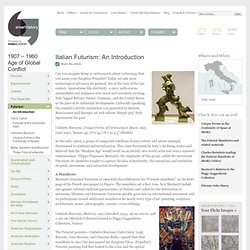

Italian Futurism. Can you imagine being so enthusiastic about technology that you name your daughter Propeller?

Today we take most technological advances for granted, but at the turn of the last century, innovations like electricity, x-rays, radio waves, automobiles and airplanes were novel and extremely exciting. Italy lagged Britain, France, Germany, and the United States in the pace of its industrial development. Culturally speaking, the country’s artistic reputation was grounded in Ancient, Renaissance and Baroque art and culture. Simply put, Italy represented the past. Umberto Boccioni, Unique Forms of Continuity in Space, 1913 (cast 1931), bronze, 43 7/8 x 34 7/8 x 15 3/4" (MoMA) In the early 1900s, a group of young and rebellious Italian writers and artists emerged determined to celebrate industrialization.
A Manifesto Marinetti launched Futurism in 1909 with the publication his “Futurist manifesto” on the front page of the French newspaper Le Figaro. Nike of Samothrace, marble, c. 190 B.C.E. Unfinished Works - Slide Show. The Metropolitan Museum is dotted with paintings that have been left incomplete.

Above, a detail of an unfinished Tintoretto sketch featuring an outlined figure that would be at home in a 20th-century work. Below, the full sketch, which pays homage to a Venetian doge. This “Virgin and Child With Saints,” circa 1472, was restored in 1983 to remove later overpainting, leaving the original sketches of Mary and St. John. The work is by a Flemish artist referred to as the Ghent Painter. Above, a detail of “The Forest in Winter Sunset” by the landscape painter Théodore Rousseaus. A close look at Ingres’s “Odalisque in Grisaille,” left, reveals a sketchy foreground. Edgar Degas’s unfinished “Madame Théodore Gobillard (Yves Morisot, 1838-1893),” a portrait of the sister of the painter Berthe Morisot seated indoors. Italian Futurism, 1909–1944: Reconstructing the Universe. Taking over nearly the entirety of NYC's Frank Lloyd Wright–designed Guggenheim Museum, the upcoming exhibition "Italian Futurism, 1909–1944: Reconstructing the Universe" will ambitiously showcase the lesser known, early 20th century art movement.

Originating in Italy in 1909, Futurism's origins lie in a high-energy manifesto written by philosopher and propagandist F.T. Marinetti, which praised the spirit of rebellion, the speed of racing cars, the beauty of the avant-garde and fundamentally, artistic freedom. Marinetti's provocative ideas went on to inspire Dadaism and Surrealism, and most importantly, a radical new way of viewing the world.
We spoke with Guggenheim curator Vivien Greene, who's been working on the exhibition since 2007, but tells us it has been a goal for the museum since she began working there 20 years ago. Futurism began as a literary concept, will their manifestos be on display? Absolutely. So the entire exhibition is punctuated by different kinds of writings. American Legends: From Calder to O’Keeffe. Renaissance and Baroque Bronzes at the Frick Collection.
Photo In case you haven’t noticed, the Frick Collection has been on something of a bronze statuette kick over the last decade.

During that time, it has mounted five monographic or survey shows of these small collectibles, all organized by the estimable curator Denise Allen. Portable bronze statuettes began to proliferate in mid-15th-century Italy as antique medals, coins and sculptures began to be collected and the musculature of the body was increasingly studied. The pieces quickly became a competitive artistic medium, frequently taken up by goldsmiths and blossoming especially in Florence. With their emphasis on mythological power struggles and sex — Hercules crushing Antaeus was big, as were upright or reclining Venuses and nymphs — the statuettes were also status symbols. What was good enough for Frick is evidently good enough for us. This is a sensational show.
The presentation is also unusual because the Hills collect more than bronzes. Artist in Residence: Alarm Will Sound. The Guggenheim Museums and Foundation. The Metropolitan Museum of Art - Home. Thomas P. Campbell: Weaving narratives in museum galleries. The Museum of Modern Art. Whitney Museum of American Art: Home.